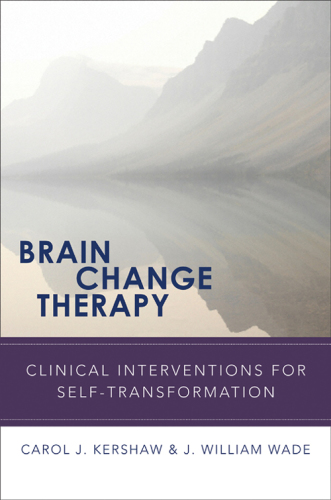درمان تغییر مغز: مداخلات بالینی برای تغییر خود ۲۰۱۲
Brain Change Therapy: Clinical Interventions for Self-Transformation 2012
دانلود کتاب درمان تغییر مغز: مداخلات بالینی برای تغییر خود ۲۰۱۲ (Brain Change Therapy: Clinical Interventions for Self-Transformation 2012) با لینک مستقیم و فرمت pdf (پی دی اف)
| نویسنده |
Carol Kershaw, J. William Wade |
|---|
| تعداد صفحهها |
354 |
|---|---|
| نوع فایل |
epub |
| حجم |
2 Mb |
| سال انتشار |
2012 |
89,000 تومان
معرفی کتاب درمان تغییر مغز: مداخلات بالینی برای تغییر خود ۲۰۱۲
کمک به مراجعان برای کنترل واکنش عاطفی خود.
در صورت تجربه مزمن، شرایطی مانند اضطراب و افسردگی مسیرهای عصبی را تعیین می کنند و درک فرد از وقایع زندگی و پاسخ به آنها را شکل می دهند. همانطور که این مسیرها تقویت می شوند، شبکه های عصبی ناسالم با سهولت فزاینده ای در حضور محرک های خودآگاه و ناخودآگاه فعال می شوند. در این کتاب پیشگامانه، کرشاو و وید، درمان شیفت مغزی (BCT) را معرفی می کنند، یک پروتکل درمانی که در آن مراجع یاد می گیرند که احساسات و رفتارهای خود را مدیریت کنند، در نتیجه استرس را کاهش داده و واکنش هیجانی را کنترل می کنند. برگرفته از آخرین تحقیقات علوم اعصاب علاوه بر اصول یکپارچه از هیپنوتیزم، بیوفیدبک و درمان شناختی، BCT به مراجعان کمک می کند تا به حالت های عصبی و عاطفی پایدار برسند و در نتیجه دیدگاه ها، نگرش ها، باورها و روایت های شخصی را به سمت مثبت گرایی تغییر دهند. BCT با این فرض شروع می شود که تغییر درمانی مؤثر ناگزیر باید شامل بازسازی مسیرهای عصبی باشد و از «نروپلاستیسیته خودگردان» از طریق تمرین فعال توجه متمرکز استفاده می کند. به عنوان مکمل این رویکردها، به مراجع کمک می کند تا تجربیات زندگی جدید و توانمندی ایجاد کند که می تواند پایه ای برای نوروتیپ های جدید باشد.
این کتاب با بسترسازی برای مداخلات بدن-ذهن-مغز-بدن با کاوش در اصول اولیه مغز آغاز می شود: آناتومی، نوروآناتومی، فیزیولوژی عصبی، فرآیندهای الکتروشیمیایی، و ریتم ها و طبیعت مغز-بدن. نویسندگان پروتکل مفصلی را برای ارزیابی عصبی و ارزیابی مراجعان جدید ایجاد کردند، و توجه ویژه ای به ارزیابی مدارهای احساسی به طور معمول فعال شده، امضاهای عصبی، شکل پذیری حالت، سطح برانگیختگی، و هر حالت عصبی زیستی مربوطه داشتند.
نویسندگان به تشریح BCT و مداخلات آن در جهت کاهش استرس و تغییر حالت، یا توانایی انتقال ذهن از یک حالت عاطفی به حالت دیگر و تغییر مغز از یک حالت عصبی به حالت دیگر می پردازند. پروتکل های مربوط به مشکلات ارائه خاص، مانند ترس، اضطراب، بیماری های تهدیدکننده زندگی، و بیماری های مزمن به تفصیل تشریح شده اند. به دلیل گستردگی رویکرد BCT، در کار با افرادی که علاقه مند به تغییر و انطباق حالت های هوشیاری با عملکرد اوج هستند، موثر است و نویسندگان پروتکل هایی را برای کمک به مشتریان خود برای رسیدن به اوج عملکرد حرفه ای نیز ارائه می دهند.
با این کتاب، پزشکان قادر خواهند بود مراجعان خود را برای یافتن راه رهایی از طیف وسیعی از شرایط روانی ناتوان کننده توانمند کنند.
When conditions like anxiety and depression are experienced chronically, they condition neural pathways and shape a person’s perception of and response to life events. As these pathways are reinforced, unhealthy neural networks turn on with increasing ease in the presence of conscious and unconscious triggers. In this groundbreaking book, Kershaw and Wade present Brain Change Therapy (BCT), a therapeutic protocol in which clients learn to manage their emotions and behaviors, and thus reduce stress and control emotional reactivity.
Drawing from the latest neuroscientific research as well as integrative principles from hypnosis, biofeedback, and cognitive therapy, BCT helps clients reach stable neurological and emotional states and thus shift perspectives, attitudes, beliefs, and personal narratives toward the positive. BCT starts with the working assumption that effective therapeutic change must inevitably include a repatterning of neural pathways, and employs “self-directed neuroplasticity” through the active practicing of focused attention. As an adjunct to these methods, it helps clients create new, empowering life experiences that can serve as the basis for new neural patterns.
The book begins by laying the foundation for body–mind and brain–body interventions by exploring the basics of the brain: its anatomy, neuroanatomy, neurophysiology, electrochemical processes, and the rhythms of the brain and body and nature. The authors set forth a detailed protocol for neuroassessment and evaluation of new clients, with particular attention to assessing a client’s habitually activated emotional circuits, neural imprints, state flexibility, level of arousal, and any relevant neurobiological conditions.
The authors go on to outline BCT and its interventions geared toward stress reduction and state change, or the capacity to shift the mind from one emotional state to another and to shift the brain from one neural pattern to another. Protocols for specific presenting problems, such as fear, anxiety, and life-threatening and chronic illnesses are outlined in detail. Because of the breadth of the BCT approach, it is effective in working with individuals who are interested in shifting and conditioning peak performance states of consciousness, and the authors offer protocols for helping their clients reach peak professional performance as well.
With this book, clinicians will be able to empower their clients to find their way out of a wide range of debilitating mental states.



